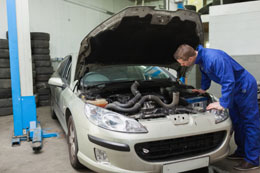
The radiator of a vehicle is its most important part, since it is helps in cooling the engine. It should be flushed regularly, after every six months. This maintains the condition of the radiator, avoids leakage from it, and also prevents it from getting damaged in any other way, and aides efficient functioning.
Flushing a Car Radiator
- You will need an engine cover or a blanket, a tub for drainage or a plastic tray, cold water, water hose, and radiator flush coolant.
- Before you start with the actual process, make sure that you turn off the engine and allow it to cool down to a normal temperature. Cover off the whole engine, except the radiator, with a blanket. This will keep the other components safe from water.
- Allow the engine to cool down completely and then take off the radiator cap.
- If the hoses appear to be brittle and they contain excessive moisture, it indicates that they are damaged. In this case, get them repaired immediately.
- There must be some amount of liquid present inside the radiator. Drain that liquid in a tub or a plastic tray. If the liquid is clean, then it indicates that the exterior part of the radiator is free from any kind of damage or rust. If it is unclean, then it is advised that you check the exterior for dirt and do the required cleaning.
- With the help of the hose and cold water, flush the radiator. Allow the water to overflow from it. This will ensure that it is cleaned thoroughly. Make sure that you clean all the sides and parts of the radiator well.
- Next, attach the hose to the cooling jacket and clean it.
- Allow the water to drain off completely and then replace the radiator cap.
- The next step is to add coolant to the radiator. Make sure that the amount of coolant that you add does not exceed or is less than what is recommended by the manufacturer.
- Re-attach the top radiator cap.
- Now, take off the engine cover, ignite the engine, and check if there are any leaks. If no coolant is present beneath the car after you start the engine, then you have successfully flushed the radiator. Test it again by taking your vehicle for a drive. After you come back, check if the cooling system is working efficiently and after the engine has cooled down, also check for the level of the coolant. This will tell you if it needs to be further topped up.
This method is basically used for cleaning and flushing of non sealed systems and can be used to flush any vehicle’s radiator. Some people use a radiator flush machine for the same.
This write-up is expected to be of help in case you wish to flush the radiator by yourself. Use the extra dough that you saved for something that you have been longing for.